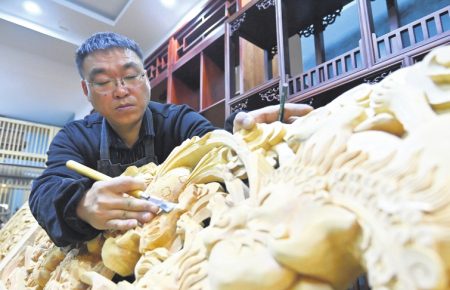Craftsman carves out new life of local legends
A piece of wood can tell the stories of Shanxi — its history, culture, landscapes and local life, Ye Yaoliang, a famed woodcarving artist said at a recent exhibition in the provincial capital of Taiyuan.
The exhibition opened on Feb 23 at the Taiyuan Cultural Center and has gathered more than 100 woodcarving works from various artists.
According to Ye, Shanxi's woodcarving has a history of nearly 2,000 years. Over millennia, the art has been a vehicle of local culture, with its themes covering historical legends and landscapes. Human figures, mountains, waterscapes, flowers, birds and animals are commonly seen in the artworks.
"We are seeing landmark attractions in Shanxi on the wood carvings displayed here, like the Yellow River, the Great Wall and the Taihang Mountains, as well as the stories and lives relating to these places," Ye said. "The land and people here are the inexhaustible sources of inspiration for woodcarving artists."
Ye said the art in Shanxi reached its peak during the Ming (1368-1644) and Qing (1644-1911) dynasties. The Shanxi merchants, who are said to have dominated commerce in North China during those periods, extensively used woodcarvings to decorate their residences, boosting the popularity and prosperity of the art.
He said he once saw a huge carved-frame mirror in the Grand Courtyard of the Qiao Family — a signature residence of the Shanxi merchants — in Qixian county. Featuring the patterns of a moon and a rhinoceros, Ye said this should be considered among the rarest woodcarving works in the world.
"But nowadays, the art has gradually faded out of local life and is on the verge of extinction," the artist said. "We deem it necessary to preserve the art and pass it down to future generations."
Ye said there are varied styles and characteristics of woodcarving arts across different regions of China. Drawing inspiration from other regions is key to reviving the art in Shanxi, he added.
Ye, now 46, started to learn the art from a master in Zhejiang province when he was 16.
After finishing his three-year apprenticeship, he returned to Shanxi, continued to learn from local artists and began to practice in this trade.
"My apprenticeship in Zhejiang rendered me a new point of view to understand the local art," Ye said. "Then I discovered there is always an air of grandeur in Shanxi's woodcarving artworks, which has been made possible by employing the perspective relation of traditional Chinese painting and portraying landscapes with a sense of depth."
Based on his understanding of the art, Ye has created many masterpieces over the past two decades. His works have been held by a number of private collectors, museums and art galleries.
He said what makes him proud is that some of his works are now displayed at the Shanxi Hall of the Great Hall of the People in Beijing.
Ye is the co-founder and vice-chairman of the Shanxi Association of Woodcarving Artists, which was established in July 2021. Wu
Jia contributed to this story.
By Yuan Shenggao












